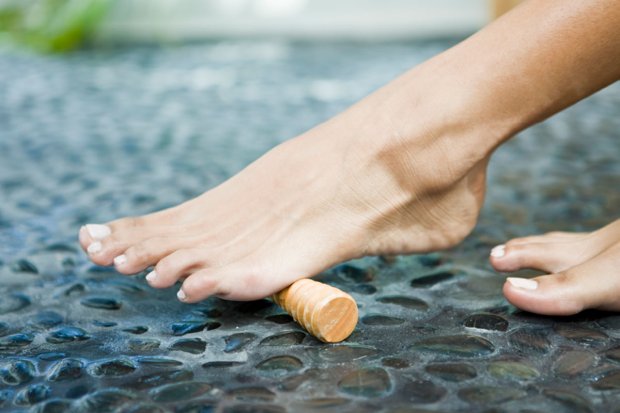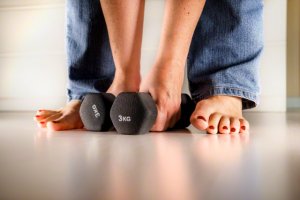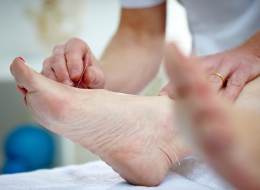Pain Relief Exercises and Yoga Stretches to Help Bunions and Bunion Pain
Working out the toes with a variety of stretches and exercises is a great way to naturally ease bunion pain and get your feet back to normal working condition.
Just as nobody likes a sore loser, nobody likes a sore toe. Unfortunately, a bunion — called hallux abducto valgus in the medical world — is a common condition that causes pain in the toes of millions of Americans each year.
Bunions occur when pressure is continuously applied to the side of big toe, which irritates the joint and forces it out of place. The misplaced big toe then begins to angle toward the second toe, resulting in an often-painful and swollen enlargement that jets out at the base of the big toe. Two common cause of bunion development: squeezing into high heels on a frequent basis and having an abnormal pronation (which is the rolling inward or outward of the foot when it comes into contact with the ground).
While bunions are considered a deformity and many doctors agree that there is no cure outside of surgery, there are a number of exercises, stretches and yoga poses that can help slow the progression of bunions as well as reduce their size and the excruciating pain that comes along with them.
Stretches to Help Bunions
Done daily, the following stretches can help ease bunion pain and reduce bunion progression:
Toe Stretch
Sit on the floor with your legs out in front of you. Point your toes straight out for five seconds and then curl them under for five seconds. Repeat this process 10 times daily.
Big Toe Alignment Stretch
Use your fingers and gently pull your big toe into proper alignment. Keep your toe in this position for 10 to 15 seconds, release, and then repeat up to five times daily.
Toe Spread
While sitting in a chair, rest your heels on the floor and then spread your toes as far apart as possible. Keep your toes spread for a few seconds, then pull them together and squeeze your foot into a fist position. Release and repeat several times daily.
Ball Roll
To help relieve foot cramping, place a small ball under the ball of your foot and roll it around under your arch. This helps massage your abductor hallucis muscle, which helps with the flexion and abduction of your big toe.
Exercises to Help Bunions
These light foot exercises will help reduce bunion pain, strengthen foot muscles and help keep your bunions from getting worse:
Big Toe Resistance Training
To strengthen the muscles in your big toe, wrap a belt, a towel, or a traditional resistance training device around the toe and use it to pull your toe toward you. At the same time, try to push your toe against the belt, towel or resistance device. Do this a couple of times daily to help keep your toe muscles strong and your hallux valgus from progressing.
Toe Pick Ups
Picking objects up off the floor with your toes is a great way to keep your feet flexible and pain free. You can use anything from marbles to small toys to rags. Whatever you decide to “pick up,” use your toes to gently pick the object up off the ground and deposit them either to the side or in a bowl or bucket. Pick up about 20 objects per day to help keep your bunion pain low.
Walking in the Sand
If you live anywhere near the beach, take advantage of your prime location and try to frequently walk barefoot in the sand. It’s an easy way to strengthen foot and toe muscles, and it gives your feet a gentle massage.
Yoga Exercises for Bunions
Believe it or not, there are quite a few yoga poses that can help strengthen and stretch the foot, as well as reduce bunion progression and pain. The trick is to think of your feet as small little tables, each with four legs. Try to keep your weight even on all of the “legs” to get the most out of the following yoga positions that help with bunions:
Downward-Facing Dog
This is a common position in beginner yoga that gives your entire foot and leg area a nice stretch. Position yourself on all fours, with your feet and your palms flat on the floor and your butt in the air. Your body should look like an upside down V. Stretch each foot individually by bending one knee and pushing the opposite heel down the floor. Switch legs and repeat a few times daily.
Garland Squat
This deep squat stretches your leg and foot muscles to help keep them strong and flexible. Stand on your tip toes and then gently lower yourself into a squatting position, keeping as high up on your toes as possible. Hold this pose for 20 to 30 seconds and then repeat a few times daily. If the position is too difficult for you to hold, you can roll up a towel and place it under your heels for added support.
A visit with a podiatrist and/or a physiotherapist can help you further determine activities and treatments that can help with your bunions and bunion pain. Just remember that the sooner you start bunion exercises, stretches and yoga poses, the slower your bunions will progress — which means less pain in the long run!
Notice concerning medical entries:
Articles having medical content shall serve exclusively for the purpose of general information. Such articles are not suitable for any (self-) diagnosis and treatment of individual illnesses and medical indications. In particular, they cannot substitute for the examination, advice, or treatment by a licensed physician or pharmacist. No replies to any individual questions shall be effected through the articles.






